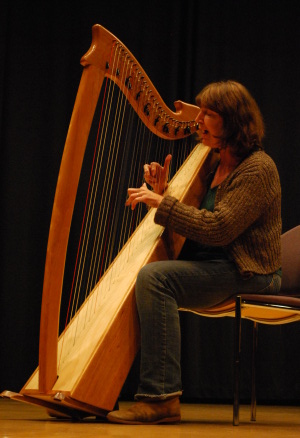photo: Floris van der Meijs

Sally Sehlin (Scotland / Sweden): The North Sea o'er
Born in Falkirk, in the lowlands of Scotland, Sally abandoned classical guitar
for folk music in the sixties, but did not forget her passion for early music.
In the years that followed she learned to play a variety of fretted and wind
instruments, singing to her own accompaniment at local folk song clubs.
Moving to Sweden via Tanzania in the late seventies, she enjoyed exploring the
Swedish folk-music tradition, and soon became involved in a variety of different
choirs and music groups, both as a member and as musical leader and arranger.
She took up playing the folk harp in 1997 and subsequently, she also started
building harps – it must just be that insatiable drive to learn new skills!
Sally loves to cross musical barriers, to experiment, to mix and match between
different epochs and genres. At the NHM 2009 in Finland, she gave a workshop
about The Musical Heritage of Al Andalus, and shared with us some old Sephardic
and Arabic/Andulusian songs from 15th century.
At the NHM 2011, Sally will give a workshop about British ballads with
Scandinavian ingredients, and Scandinavian tunes with British flavour. A number of
musical parallels, themes and historical references can be found in the traditional music
in the Nordic countries and those parts of Britain which have once been under
Scandinavian rule. What do ravens like to eat for dinner? How do they dance on the Isle of Mann?
Where is Sule Skerry? Do they like chocolate and buns in Newcastle?
The answers to these and many other questions will be revealed in Sally's circle
"The North Sea O'er" where we will explore the parallels and connections in the
musical and cultural heritages of Britain and Scandinavia.
One of these connections is the ballad Sir Patrick Spence,
which probably commemorates ship wrecking events which accompanied the marriage of Margaret,
daughter of Alexander III of Scotland, to Erik II Magnusson of Norway, in 1281.
Another more recent example is a traditional dance tune known in various local versions
in Denmark, Finland, Norway and Sweden, but which is apparently derived from a Scottish
hornpipe imported by sailors.
All instruments, including voices, are invited!



